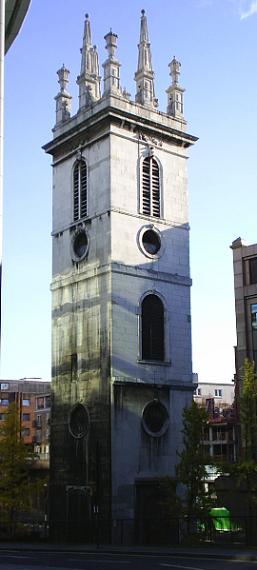St Mary Somerset facts for kids
Quick facts for kids St. Mary Somerset |
|
|---|---|

Photo of the tower of St. Mary Somerset
|
|
| 51°30′40.92″N 0°5′48.80″W / 51.5113667°N 0.0968889°W | |
| Location | Queenhithe, City of London |
| Country | England |
| Denomination | Church of England |
| Architecture | |
| Architect(s) | Sir Christopher Wren |
| Style | Baroque |
| Demolished | 1871 |
St. Mary Somerset was a historic church located in the City of London, England. It was first mentioned in records way back in the 1100s. Sadly, the church was destroyed in the terrible Great London Fire of 1666.
After the fire, it was one of 51 churches rebuilt by the famous architect, Sir Christopher Wren. Today, only the tower of St. Mary Somerset remains. You can find it on Upper Thames Street. The main part of the church was taken down in 1871.
Contents
A Look Back: The History of St. Mary Somerset
Before the Great Fire, London had 14 churches named after the Virgin Mary. Six of these were rebuilt after the fire, including St. Mary Somerset. No one is completely sure where the name Somerset came from. Some people think it might be linked to a person named Ralph de Somery from that time. Others believe it comes from Summer's Hithe, which was a small port on the Thames River. In the Middle Ages, this port would have been very close to where the church stood. The church is first mentioned in official papers during the time of King Richard the Lionheart.
In 1370, the Mayor of London told weavers from Brabant (a region in what is now Belgium) to meet in the churchyard of St. Mary Somerset. This was so they could hire helpers, after some disagreements with weavers from Flanders. The Flemish weavers had to meet somewhere else, at the churchyard of St Laurence Pountney, to keep things peaceful.
Rebuilding After the Great Fire
After the Great Fire, the area around St. Mary Somerset was combined with the area of St Mary Mounthaw. That church was not rebuilt. Construction on the new St. Mary Somerset church began in 1686. It was one of the last churches to start being rebuilt by Wren's team. Work stopped in 1688 because of money problems during the Glorious Revolution. This was a time of big political change in England.
Building started again the next year, and the church was finished in 1694. It cost about £6,579 to build. The people living in the church's area were not very wealthy. St. Mary Somerset was one of only two churches for which Wren used money from the Coal Tax to buy furniture and other items. The rebuilt church was smaller than the old one. This was because the city took some land to make Thames Street wider.
Notable People and Events
Gilbert Ironside the younger, a leader at Oxford University, was buried here in 1701. He was known for standing up to King James II. His body and tombstone were later moved to Hereford Cathedral in 1867.
In the late 1700s, the church was known for its "Low Church" style. This meant it was less formal than some other churches. A writer named James Peller Malcolm noted in 1803 that the church often looked messy. This was because a well-known preacher, William Alphonsus Gunn, held services there.
In 1805, the church's special communion plates were stolen. They were never found. For a long time, the Bishop of Hereford was in charge of the church. But in the mid-1800s, this responsibility was given to the Bishop of London.
Why the Church Was Demolished
In the second half of the 1800s, many people moved out of the City of London. They went to live in new suburbs around the city. This meant that many city churches had very few people attending services. At the same time, many new suburbs had no churches at all.
To fix this, a law called the Union of Benefices Act 1860 was passed. This law allowed old city churches to be taken down. The land could then be sold to build new churches in the suburbs. The last service at St. Mary Somerset was held on February 1, 1867. About 70 people attended. The church's area was then combined with that of St Nicholas Cole Abbey. The church building itself was taken down in 1871.
However, the architect Ewan Christian insisted that the church tower should be saved. The money from selling the church land was used to build a new church called St. Mary Hoxton. This new church also received the old church's furniture and bell.
Before the Second World War, the church tower was used as a rest room for women. Today, the tower stands on a small island in the middle of a road. It is surrounded by a small, pretty garden.
The Building: What the Tower Looks Like
The church built by Sir Christopher Wren had a simple design. It was a single room with a flat roof. One person described the inside as "just a room with low white walls." There was a balcony on the west side, supported by two columns. A royal coat of arms hung from this balcony.
The tower sticks out from the southwest side of where the church used to be. It is 120 feet tall and made of Portland stone. This is a type of white limestone. Up each side of the tower, there are rows of windows. Some are round, and some have rounded tops. You can see interesting carvings of faces and cherubs above the windows.
The most special part of the tower are its eight Baroque pinnacles. These are tall, decorative points at the top. The four pinnacles on each corner have fancy bases and scrolls, with vases on top. Between these, there are 20-foot tall pointed pillars called obelisks, with round balls on their tips. Many experts believe these unique designs were created by Nicholas Hawksmoor, another famous architect. These pinnacles create a cool optical illusion. They seem to change height when you look at them from different places.
The pinnacles were taken down after the Second World War. This was because they were damaged during the London Blitz, when bombs fell on London. But the City Corporation restored them in 1956. The remaining tower was given a special protection status as a Grade I listed building on January 4, 1950. This means it is a very important historic building.
The tower is currently being fixed up and made into a private family home by a company called Pilbrow and Partners.
See also


